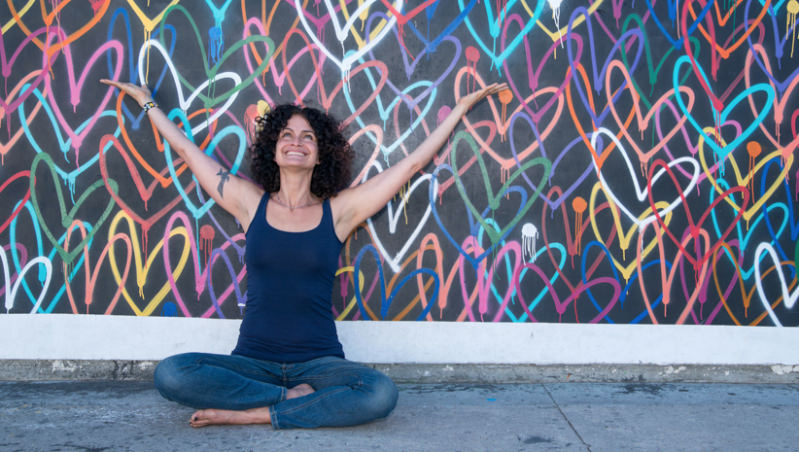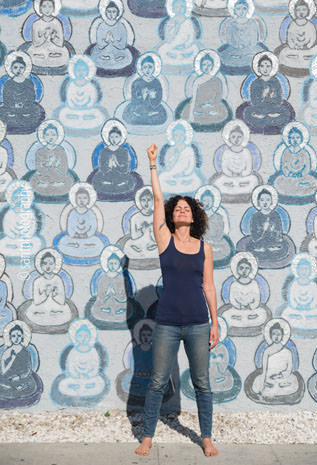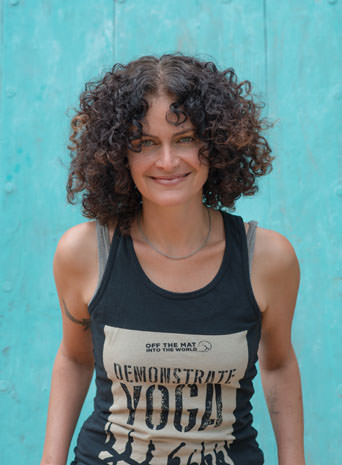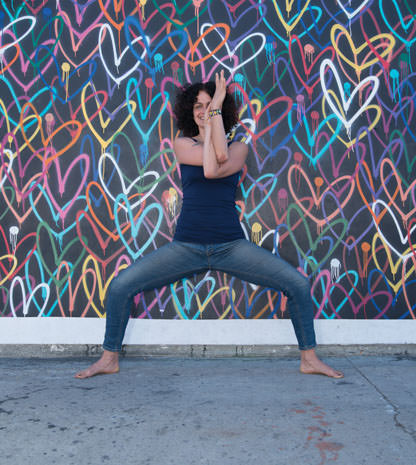
Hala Khouri photographed by Sarit Rogers
Every time Hala Khouri leads her online or in-person trauma-informed trainings designed to inform and empower yoga teachers and clinicians to recognize the various ways in which trauma appear in the body, she assures her students, “The wound is the gift. And the gift is the wound.” The more time I spend practicing and training with Hala, the more meaning I uncover in this phrase, so much so that I’ve begun hearing myself say it to my own students. This phrase is the answer to our panicked SOS about emotional and physical pain, letting us know that the wounds that cause our suffering are the very things that can provide us with profound gifts we are able to share with others. For example, the “gift” of hyper-vigilance can also be a hyper-awareness of the suffering of others, an ability to attune and be empathetic. The path to this process involves looking inward, dancing with the shadow, and softening the edges so our wounds can begin to heal.
As a teacher, Hala skillfully creates a safe container for people to begin this process of healing. The phrases she uses can shift a practice. They include, “Bring a little tone to the low belly and let your lower back know, ‘Hey, I got you!’” or in savasana, “Bring your awareness to the parts of your body touching the ground, notice what’s got your back.” Hala provides her students with invitations to investigate a shape, or choose the version of a pose that is available to them. This method of teaching is liberating. Suddenly, students are given the sense of “I can” instead of “I’m not as good as…”
I first met Hala Khouri in 2013 when I was a student in the Awakened Heart, Embodied Mind teacher training she leads annually with Julian Walker and Jay Fields. Even before we met in person, I was inspired by the way she dedicates her voice for social justice along with her passion for facilitating positive change by educating others through workshops, teacher trainings, and public classes.

Photo of Hala Khouri by Sarit Rogers
The roots of her passion for this work are seen in her own journey. As she says, “We begin by admitting that we do this work because we want to heal ourselves.” Hala was born in Beirut, Lebanon, where her father was a physician in a local hospital. Every day he was picked up by tanks and driven up a hill visible from Hala’s home. The family would watch, wondering if the next explosion would be his tank. Yet Hala felt protected by her family and her mother’s clever storytelling that shielded her from some of the terrors of war. The family got out of Beirut in 1976, shortly after the war broke out—Hala was three years old at the time. Although Hala says that the effects of living in a war zone has shaped her, she doesn’t feel she has sustained trauma from the experience because of how protected she was.
Hala’s family was able to obtain their paperwork and leave Beirut and her father soon landed a job in the US, a fact Hala recognizes was indicative of their economic, class, and educational privilege. Her awareness of social injustice, inequity, and inequality are integral to her work. Everything she does, be it direct activism or through her entertainment, is informed by this consciousness of injustice in the world.
In her late twenties, as Hala was finishing her Master’s degree in counseling psychology at Pacifica Graduate Institute, she was working with a therapist who was a Somatic Experiencing™ Practitioner (SEP). During her post-graduate traineeship, she realized the importance of including the body in therapy, and this led her to train with the Somatic Experiencing™ Trauma Institute (SETI), founded by Peter Levine. Hala has been a Somatic Experiencing™ Practitioner for 15 years; SE® provides her with the distinctive trauma training and tools she needs to train others. In addition to what she does through teacher training and her public classes, her work with people with PTSD and underserved youth gives her an ability to see and address the various ways in which trauma shows up in the body. Hala’s present-time awareness of her state of mind and body, as well as her ability to track her own physiology, allows her to be grounded and present. I think of her as a trauma ninja with the puzzle-solving skills of Sherlock Holmes.

Hala Khouri photographed by Sarit Rogers
When Hala trains people to work in the realms of releasing trauma and promoting justice, she also encourages people to play. She reminds us that it doesn’t serve anyone if we stay in the red (stress zone) if we don’t have to, because there are enough people who don’t have the privilege to take a break from trauma or stress. In order to do this work sustainably, we have to nourish ourselves. Hala notes that all of her mentors have creative hobbies. Her go-to is to dance! She loves sharing this playfulness with others; even in her drop-in classes, there is often a random dance party.
Hala Khouri recognizes that doing yoga doesn’t mean you’re in a constant state of bliss. She sees how it can be used to bypass pain and discomfort under the guise of being spiritual. Hala shares that she used to to do this a lot using magical thinking to visualize her problems away. When she sees others doing this, she has compassion. Eventually she realized, “There is suffering in life. Yoga and meditation can help us cope with suffering, but we can’t avoid it. When we avoid suffering we also avoid the joy that comes from being present in life.” Though it was a tough awakening, it came with a sense of relief coupled with the recognition that all the ways she was avoiding suffering were the things that were ultimately imprisoning her. The bridge Hala creates is in an invitation for her students to be curious about their sensations and emotions, to notice what’s arising and passing and to meet it with awareness and presence.
Like many of us, Hala found yoga because it was good exercise and it made her feel better physically. She taught her first yoga class in 1999 as a sub for her teacher in New York after 10 years as a fitness instructor. Teaching yoga felt “… like being home…” so she subsequently pursued formal yoga teacher training. Hala learned a great deal from her mentors, and when they started practicing yoga, she also shifted away from aggressive exercise practices to more mindful ones like yoga.

Hala Khouri Photographed by Sarit Rogers
Hala says, “Yoga is a tool for self-regulation.” This is connected to the work to release trauma that she and I are both learning. She also says, “Yoga teaches us to tolerate discomfort. It teaches us to get curious and not run away from our experiences. If I can inspire people to understand that, then I feel like I’ve done my work in the world because I know that running away is often what causes suffering, even more than the things we’re running away from.”
One of the ways Hala is committed to her work in the world is through the nonprofit organization Off the Mat, Into the World, which she co-founded with Seane Corn and Suzanne Sterling 10 years ago. They are in a process of constant collaboration, practicing both within the organization as co-facilitators and in their work with activists in training as well as communities they serve. When I took an Off the Mat Intensive, I was struck by how involved the three of them are as they continually explore and investigate their relationships with themselves. I can relate to their commitment to doing the work of releasing trauma and promoting social justice with intention and without the sound and fury. The goal is the same, no matter what “side” we are on – to be liberated from suffering.
When thinking about Hala, I am reminded of something I recently heard Rabbi Moshe Bryski say, “Unity doesn’t mean we become one, it means that each of us in our uniqueness come together to create peace.” Hala’s work is connected to compassion and justice for all, yet without the need for everyone to be the same; the inclusion of all bodies, races, abilities, ethnicities, sexual identities and genders in her work speaks to her dedication. We are unique and autonomous, but our goals are similar. We desire to suffer less, to be seen and heard and cared for, to have access to resources, to thrive, and to be supported and loved. Walking into a class that Hala is teaching is like coming home to a place where everyone shows up just as they are: it’s welcoming, it’s accepting, and it’s accessible for every body.
Hala Khouri can be found at Santa Monica Yoga on Mondays (all levels) and Fridays (Yoga for All Bodies) at Santa Monica Yoga. Hala’s website is: halakhouri.com
Sarit Rogers is a photographer, yoga teacher, writer, and founder of the LoveMore Movement, who is a Somatic Experiencing™ Practitioner. She is also a contributor in the anthology Yoga Rising, by Melanie Klein: saritphotography.com. saritzrogers.com
